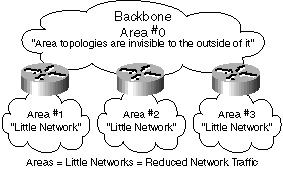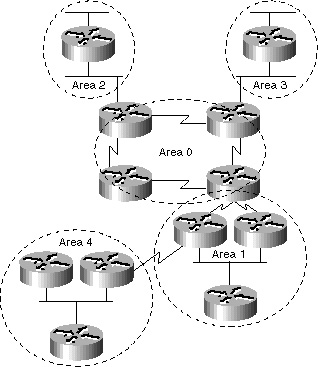The Fundamentals of OSPF Routing Design
Justifying the Use of Areas and Multiple AreasAreas are essentially little networks within the larger network, and as such, they route only necessary traffic within themselves, thereby reducing overall network traffic. There are many reasons that using OSPF’s capability to create areas would result in benefits for your network. The use of areas is necessary so the OSPF’s required hierarchical structure can be put into place. The topology of the network within an area is invisible to anything outside of that area, as demonstrated in Figure 5-5.
Non-Stub Area CharacteristicsNon-stub areas carry a default route, static routes, intra-area routes, and external routes. An area must be a non-stub area when it contains a router that uses both OSPF and any other protocol, such as the Routing Information Protocol (RIP). Such a router is known as an autonomous system border router (ASBR). An area must also be a non-stub area when a virtual link is configured across the area. Non-stub areas are the most resource-intensive type of area. The LSDB Within an AreaThe LSDB is everywhere within an OSPF network. When encountered in an area, the LSDB will be identical in each router within the area. The LSDB will also contain a variety of LSAs, as follows:
Area Partitions: Outages or Network Growth?Area partitions will typically occur within an area. OSPF does not actively attempt to repair area partitions. When an area becomes partitioned the new sections simply become separate areas. As long as the backbone can reach both of them, it will continue to route information to them. To maintain routing, an IP address range must not be spread across the split area. This assumes that some destinations will now require inter-area routing as a result. If this does occur, then some destinations will become unreachable and routing loops could occur. In an outage condition this information is not very helpful, but when designing areas, assign IP address ranges accordingly so that growth can be handled easier in the future should a new area be needed. The backbone should never be partitioned, but if it does occur, then consider using a virtual link to temporarily repair the backbone. Virtual links are discussed later in this chapter. Even though partitioning your OSPF backbone is considered bad practice, there are times when it could be beneficial, so OSPF does allow it. For example, a company is trying to merge two separate OSPF networks into one network with a common area 0. In other instances, virtual links are added for redundancy in case some router failure causes the backbone to be split into two. Whatever the reason might be, a virtual link can be configured between separate ABRs that touch area 0 from each side and have a common area (see Figure 5-6).
In Figure 5-6, two area 0s are linked together via a virtual link. In case a common area does not exist, an additional area, such as area 3, could be created to become the transit area. In case any area that is different than the backbone becomes partitioned, the backbone will take care of the partitioning without using any virtual links. One part of the partitioned area will be known to the other part via inter-area routes rather than intra-area routes. The Golden Rules of Area DesignWhen you begin to design your OSPF network, it will be necessary for you to start with the area 0 the backbone area of every OSPF network. There are two very important rules that, if followed, will get you started properly:
The following are more general rules and OSPF capabilities that will help ensure that your OSPF network remains flexible and provides the kind of performance needed to deliver reliable service to all of its users:
Considering Physical Proximity When Defining Areas If a particular location is densely connected, create an area specifically for nodes at that location. This will enable OSPF to better handle a large, dense cluster of nodes, and it will enable more efficient management and routing. Reducing the Maximum Size of Areas if Links Are Unstable If your internetwork includes unstable links, consider implementing smaller areas to reduce the effects of route flapping. Whenever a route is lost or comes online, each affected area must converge on the new topology. The Dijkstra algorithm will run on all the affected routers. By segmenting your network into smaller or multiple areas, you can isolate unstable links and deliver more reliable overall service. This is always of benefit to everyone concerned. Ensuring Contiguous Individual Areas A contiguous OSPF area is one in which a continuous path can be traced from any router in an area to any other router in the same area. This does not mean that all routers must share a common network media (like Ethernet). Refer to Figure 5-7 which demonstrates both concepts.
Ideally, areas should have multiple redundant internal and external links to prevent partitioning.
|
EAN: 2147483647
Pages: 200


